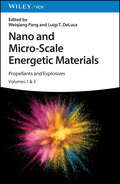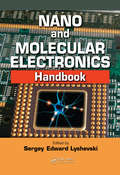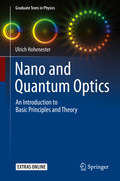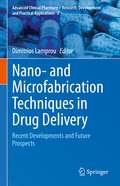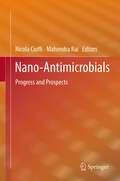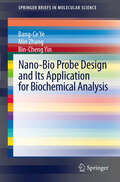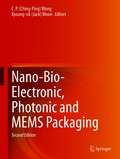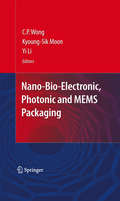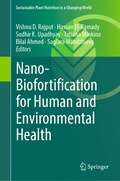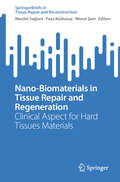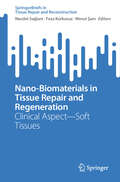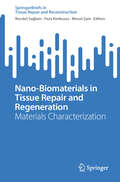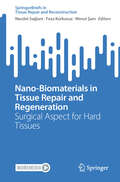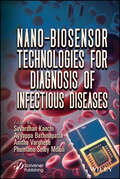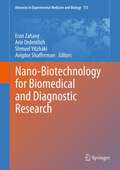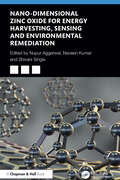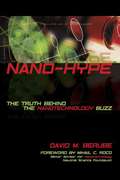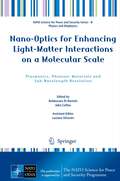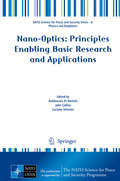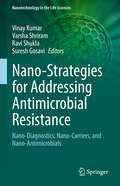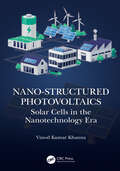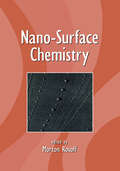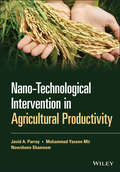- Table View
- List View
Nano and Micro Diamond Formation in Nature: Ultrafine Carbon Particles on Earth and Space (SpringerBriefs in Earth Sciences)
by Sergei Simakov Vittorio Scribano Nikolai Melnik Victor Pechnikov Irina Drozdova Vladimir Vyalov Mikhail NovikovIn this book, readers will gain a deep understanding of the distinct characteristics and intricate formation mechanisms behind each type of diamond.A standout feature of this book is its in-depth exploration of nanodiamonds, shedding light on their unique formation processes. The narrative is thoughtfully organized, covering four main categories of natural diamonds and their related formation processes: 1)Interstellar nanodiamond particles; 2) Nano- and microcrustal diamonds associated with coals, sediments, and metamorphic rocks; 3) Nanodiamonds and microdiamonds associated with secondary alterations of mafic and ultramafic rocks mainly in the oceanic lithosphere; 4) Mantle-derived diamonds associated with kimberlites and their xenoliths, such as peridotites and eclogites.With clarity and precision, this book caters to both researchers and students in the fields of mineralogy and mineral formation. This book serves as an invaluable resource, offering an all-encompassing perspective on diamond formation, appealing to those curious minds eager to delve into the captivating realm of these precious gems.
Nano and Micro-Scale Energetic Materials: Propellants and Explosives
by Luigi T. DeLuca Weiqiang PangProvides an up-to-date account of innovative energetic materials and their potential applications in space propulsion and high explosives Most explosives and propellants currently use a small number of ingredients, such as TNT and nitrocellulose. In comparison to conventional materials, nano- and micro-scale energetic materials exhibit superior burning characteristics and much higher energy densities and explosive yields. Nano and Micro-scale Energetic Materials: Propellants and Explosives provides a timely overview of innovative nano-scale energetic materials (nEMs) and microscale energetic materials (µEMs) technology. Covering nEMs and µEMs ingredients as well as formulations, this comprehensive volume examines the preparation, characterization, ignition, combustion, and performance of energetic materials in various applications of propellants and explosives. Twenty-two chapters explore metal-based pyrotechnic nanocomposites, solid and hybrid rocket propulsion, solid fuels for in-space and power, the sensitivity and mechanical properties of explosives, new energetic materials, and more. Explores novel energetic materials and their potential for use in propellants and explosives Summarizes the most recent advances of leading research groups currently active in twelve countries Discusses how new environmentally friendly, high-combustion energetic materials can best be used in different applications Explains the fundamentals of energetic materials, including similarities and differences between composite propellants and explosives Nano and Micro-scale Energetic Materials: Propellants and Explosives is an important resource for materials scientists, explosives specialists, pyrotechnicians, environmental chemists, polymer chemists, physical chemists, aerospace physicians, and aerospace engineers working in both academia and industry.
Nano and Molecular Electronics Handbook (Nano and Microengineering Series)
by Sergey Edward LyshevskiThere are fundamental and technological limits of conventional microfabrication and microelectronics. Scaling down conventional devices and attempts to develop novel topologies and architectures will soon be ineffective or unachievable at the device and system levels to ensure desired performance. Forward-looking experts continue to search for new paradigms to carry the field beyond the age of microelectronics, and molecular electronics is one of the most promising candidates. The Nano and Molecular Electronics Handbook surveys the current state of this exciting, emerging field and looks toward future developments and opportunities.Molecular and Nano Electronics ExplainedExplore the fundamentals of device physics, synthesis, and design of molecular processing platforms and molecular integrated circuits within three-dimensional topologies, organizations, and architectures as well as bottom-up fabrication utilizing quantum effects and unique phenomena.Technology in ProgressStay current with the latest results and practical solutions realized for nanoscale and molecular electronics as well as biomolecular electronics and memories. Learn design concepts, device-level modeling, simulation methods, and fabrication technologies used for today's applications and beyond.Reports from the Front Lines of ResearchExpert innovators discuss the results of cutting-edge research and provide informed and insightful commentary on where this new paradigm will lead. The Nano and Molecular Electronics Handbook ranks among the most complete and authoritative guides to the past, present, and future of this revolutionary area of theory and technology.
Nano and Quantum Optics: An Introduction to Basic Principles and Theory (Graduate Texts in Physics)
by Ulrich HohenesterThis classroom-tested textbook is a modern primer on the rapidly developing field of quantum nano optics which investigates the optical properties of nanosized materials. The essentials of both classical and quantum optics are presented before embarking through a stimulating selection of further topics, such as various plasmonic phenomena, thermal effects, open quantum systems, and photon noise. Didactic and thorough in style, and requiring only basic knowledge of classical electrodynamics, the text provides all further physics background and additional mathematical and computational tools in a self-contained way. Numerous end-of-chapter exercises allow students to apply and test their understanding of the chapter topics and to refine their problem-solving techniques.
Nano- and Microfabrication Techniques in Drug Delivery: Recent Developments and Future Prospects (Advanced Clinical Pharmacy - Research, Development and Practical Applications #2)
by Dimitrios LamprouNew materials and manufacturing techniques are evolving with the potential to address the challenges associated with the manufacture of medicinal products that will teach new tricks to old drugs. Nano- and microfabrication techniques include manufacturing methods such as additive manufacturing, lithography, micro-moulding, spray drying, and supercritical fluids among many others. The increasing resolution of new techniques allow researchers to produce objects with micrometric resolutions. This book follows a consecutive order, beginning with a background in the current field and limitations in the manufacturing of different pharmaceutical products, moving on the classification of each method by providing recent examples, and future prospective on a variety of traditional and new Nano and microfabrication techniques. A focus on the materials used to prepare these systems and their biocompatibility, including applied topics such as clinical applications and regulatory aspects also covered, offering the reader a holistic view of this rapidly growing field.
Nano-Antimicrobials
by Mahendra Rai Nicola CioffiThere is a high demand for antimicrobials for the treatment of new and emerging microbial diseases. In particular, microbes developing multidrug resistance have created a pressing need to search for a new generation of antimicrobial agents, which are effective, safe and can be used for the cure of multidrug-resistant microbial infections. Nano-antimicrobials offer effective solutions for these challenges; the details of these new technologies are presented here. The book includes chapters by an international team of experts. Chemical, physical, electrochemical, photochemical and mechanical methods of synthesis are covered. Moreover, biological synthesis using microbes, an option that is both eco-friendly and economically viable, is presented. The antimicrobial potential of different nanoparticles is also covered, bioactivity mechanisms are elaborated on, and several applications are reviewed in separate sections. Lastly, the toxicology of nano-antimicrobials is briefly assessed.
Nano-Bio Probe Design and Its Application for Biochemical Analysis
by Min Zhang Bin-Cheng Yin Bang-Ce YeIn this volume, Prof. Ye and his coworkers propose and review the concept of nano-bio probe design for biochemical analysis on the basis of their recent published works. A unique biochemical analysis technology based on fluorescence polarization enhanced by nanoparticles is described here with successful applications in environmental monitoring, rapid and sensitive sensing protease activity and high-throughput screening of inhibitors. Furthermore, they introduce a versatile molecular beacon (MB)-like probe for the multiplex sensing of targets such as sequence-specific DNA, protein, metal ions and small molecule compounds based on the self-assembled biomolecule-graphene conjugates. Besides, some colorimetric and luminescence probes utilizing metal nanoparticles for biochemical applications are also presented, such as chiral enantiomer discrimination and separation, environmental monitoring, clinic diagnosis and etc.
Nano-Bio- Electronic, Photonic and MEMS Packaging
by Yi Li Kyoung-Sik Jack Moon C. P. Ching-Ping WongThis book shows how nanofabrication techniques and nanomaterials can be used to customize packaging for nano devices with applications to electronics, photonics, biological and biomedical research and products. It covers topics such as bio sensing electronics, bio device packaging, MEMS for bio devices and much more, including:Offers a comprehensive overview of nano and bio packaging and their materials based on their chemical and physical sciences and mechanical, electrical and material engineering perspectives;Discusses nano materials as power energy sources, computational analyses of nano materials including molecular dynamic (MD) simulations and DFT calculations;Analyzes nanotubes, superhydrophobic self-clean Lotus surfaces;Covers nano chemistry for bio sensor/bio material device packaging.This second edition includes new chapters on soft materials-enabled packaging for stretchable and wearable electronics, state of the art miniaturization for active implantable medical devices, recent LED packaging and progress, nanomaterials for recent energy storage devices such as lithium ion batteries and supercapacitors and their packaging. Nano- Bio- Electronic, Photonic and MEMS Packaging is the ideal book for all biomedical engineers, industrial electronics packaging engineers, and those engaged in bio nanotechnology applications research.
Nano-Bio- Electronic, Photonic and MEMS Packaging
by C. P. Wong Yi Grace Li Kyoung-Sik MoonNanotechnologies are being applied to the biotechnology area, especially in the area of nano material synthesis. Until recently, there has been little research into how to implement nano/bio materials into the device level. "Nano and Bio Electronics Packaging" discusses how nanofabrication techniques can be used to customize packaging for nano devices with applications to biological and biomedical research and products. Covering such topics as nano bio sensing electronics, bio device packaging, NEMs for Bio Devices and much more.
Nano-Biofortification for Human and Environmental Health (Sustainable Plant Nutrition in a Changing World)
by Hassan El-Ramady Vishnu D. Rajput Tatiana Minkina Sudhir K. Upadhyay Bilal Ahmed Saglara MandzhievaNanotechnology has shown great potential to alleviate increasing pressure to meet food needs for our increasing human population, Novel agricultural innovations are required to enhance the health of edible crops and per unit area yield without impacting the associated environment in a negative way. Recent advancements in nanotechnology-based agricultural solutions have proven to help overcome the problems in agriculture that are associated with run-off of essential fertilizers from agricultural soils, low nutrient accumulation by crops, as well as to control insects, pests, and seasonal biotic factors, treatment of wastewater used for irrigation, plant uptake of xenobiotics (heavy metals, pesticides, industrial chemicals, drugs, and so on) that may be present in contaminated soils. Additionally, the consumption of such food crops may result in malnourishment and plant-mediated transfer of toxic substances among humans especially in underprivileged and rural populations. Agents to stimulate plant growth include various types of nanomaterials such as carbon nanotubes, metal, and metal-oxide nanoparticles. Applications of particular nutrients or elements in crop plants can be shown to aid human nourishment (either by directly inducing its uptake or indirectly through enhancing the intracellular levels of other associated elements that ultimately boost the synthesis of the desired nutrient in plants). It is also important to consider the competence and fate of nanomaterials in soil ecosystems. The entry route of nanomaterials into the environment includes both natural and anthropogenic sources. In order to achieve sustainable and safe use of nanotechnological products in agriculture, similar environmental conditions must be simulated on lab scale with the careful selection of organisms related to agriculture. Thus, emphasis should be placed on the judicial use of nano-enabled products without compromising the sustainability of the environment and human health. This comprehensive book highlights recent field research as well as contributions from academicians in the lab. This book addresses the major aspects related to nanotechnology, biofortification of crops, and human and environmental health.
Nano-Biomaterials in Tissue Repair and Regeneration: Clinical Aspect for Hard Tissues Materials (Tissue Repair and Reconstruction)
by Feza Korkusuz Necdet Sağlam Mesut ŞamThis book covers the clinical application of nano-biomaterials in hard tissue repair and regeneration which are materials designed to interact with biological systems to restore and regenerate damaged tissues. These materials serve as scaffolds that mimic the natural extracellular matrix (ECM), providing structural support and biochemical cues necessary for cellular activities. The physical and chemical properties of biomaterials can be tailored to specific applications, such as bone regeneration, cartilage repair, wound healing, and organ transplantation. Biomaterials influence cell behavior and tissue formation by controlling factors like mechanical strength, porosity, and surface topography. This book is suitable to students, academics, and clinical practitioners who are interested in the advancements of regenerative medicine.
Nano-Biomaterials in Tissue Repair and Regeneration: Clinical Aspect—Soft Tissues (Tissue Repair and Reconstruction)
by Feza Korkusuz Necdet Sağlam Mesut ŞamThis book covers the clinical application of nano-bio-materials in hard tissue repair and regeneration which are materials designed to interact with biological systems to restore and regenerate damaged tissues. These materials serve as scaffolds that mimic the natural extracellular matrix (ECM), providing structural support and biochemical cues necessary for cellular activities. The physical and chemical properties of biomaterials can be tailored to specific applications, such as bone regeneration, cartilage repair, wound healing, and organ transplantation. Biomaterials influence cell behavior and tissue formation by controlling factors like mechanical strength, porosity, and surface topography. This book is suitable for students, academics, and clinical practitioners who are interested in the advancements of regenerative medicine.
Nano-Biomaterials in Tissue Repair and Regeneration: Materials Characterization (Tissue Repair and Reconstruction)
by Feza Korkusuz Necdet Sağlam Mesut ŞamThis book covers the characterization of nano-biomaterials in tissue repair and regeneration which are materials designed to interact with biological systems to restore and regenerate damaged tissues. These materials serve as scaffolds that mimic the natural extracellular matrix (ECM), providing structural support and biochemical cues necessary for cellular activities. The physical and chemical properties of biomaterials are tailored to specific applications, such as bone regeneration, cartilage repair, wound healing, and organ transplantation. Biomaterials influence cell behavior and tissue formation by controlling factors like mechanical strength, porosity, and surface topography. This book provides an overview of the topic from the biomaterials’ characterization point of view and is suitable for students, academics, and clinical practitioners who are interested in the advancements of regenerative medicine.
Nano-Biomaterials in Tissue Repair and Regeneration: Surgical Aspect for Hard Tissues (Tissue Repair and Reconstruction)
by Feza Korkusuz Necdet Sağlam Mesut ŞamThis book covers the clinical application of nano-biomaterials in hard tissue repair and regeneration which are materials designed to interact with biological systems to restore and regenerate damaged tissues. These materials serve as scaffolds that mimic the natural extracellular matrix (ECM), providing structural support and biochemical cues necessary for cellular activities. The physical and chemical properties of biomaterials can be tailored to specific applications, such as bone regeneration, cartilage repair, wound healing, and organ transplantation. Biomaterials influence cell behavior and tissue formation by controlling factors like mechanical strength, porosity, and surface topography. This book is suitable to students, academics, and clinical practitioners who are interested in the advancements of regenerative medicine.
Nano-Biosensor Technologies for Diagnosis of Infectious Diseases
by Anitha Varghese Suvardhan Kanchi Ayyappa Bathinapatla Phumlane Selby MdluliThe book offers a thorough exploration of revolutionary nano-biosensor technologies that enables rapid, accurate detection of infectious diseases, critical for effective disease management in today’s world. Nano-Biosensor Technologies for Diagnosis of Infectious Diseases delves into the cutting-edge developments in nano-biosensor technology, a transformative innovation for the field of medical diagnostics. Nano-biosensors integrate nanomaterials like nanoparticles, nanowires, and nanotubes with biological recognition elements such as antibodies, nucleic acids, or enzymes to create highly sensitive and specific detection systems. These sensors exploit unique properties of nanomaterials to detect minute quantities of pathogens or biomarkers with remarkable accuracy, enabling early diagnosis and monitoring of infectious diseases. The integration of electrochemical, optical, and piezoelectric detection mechanisms further enhances the versatility and efficiency of these nano-biosensors, allowing for rapid, real-time analysis that is crucial for effective disease management. In the context of infectious diseases, nano-biosensors become particularly significant, as they can facilitate point-of-care testing (POCT), offering rapid and portable diagnostic solutions. This capability is invaluable in resource-limited settings and during outbreaks where traditional laboratory infrastructure may be lacking. The COVID-19 pandemic underscores the importance of swift and accurate diagnostic tools, spurring accelerated innovation and commercialization efforts in this domain. Nano-biosensors are now being developed and deployed to detect a wide range of pathogens with high sensitivity, providing a powerful tool in the global fight against infectious diseases. Nano-Biosensor Technologies for Diagnosis of Infectious Diseases provides a comprehensive overview of these technological advancements, exploring their applications, challenges, and future directions in the diagnosis and management of infectious diseases. Audience Biomedical engineers, material chemists, researchers, students, policymakers, and healthcare professionals interested in integrating nanomaterials in infectious disease care
Nano-Biotechnology for Biomedical and Diagnostic Research
by Arie Ordentlich Avigdor Shafferman Eran Zahavy Shmuel YitzhakiThe title "Nano Biotechnology for Biomedical and Diagnostics Research" will address research aspects related to nanomaterial in imaging and biological research, nanomaterials as a biosensing tool, DNA nanotechnology, nanomaterials for drug delivery, medicinal and therapeutic application and cytotoxicity of nanomaterials. These topics will be covered by 16 different manuscripts. Amongst the authors that will contribute to the book are major scientific leaders such as S. Weiss - UCLA, I. Willner, and G. Golomb - HUJI, S. Esener - UCSD, E.C. Simmel - Tech. Univ. Munchen, I. Medintz - NRL, N. Hildebrandt - Université Paris and more. The manuscripts in the book intend to present specifically biological, diagnostics and medical problems with their potential solution by nano technology or materials. In this respect this book is unique, since it would arise from the biological problems to the nano technology possible solution and not vice versa.
Nano-Dimensional Zinc Oxide for Energy Harvesting, Sensing, and Environmental Remediation
by Naveen Kumar Nupur Aggarwal Shivani SinglaZinc oxide (ZnO) nanostructures have gained significant attention in recent years due to their applications in various fields. The book provides a comprehensive overview of the recent advances in ZnO-based nanostructures for energy harvesting, sensing, and environmental remediation applications. It covers advanced aspects of application-based research on ZnO nanostructures. The book also includes biosynthesized ZnO nanostructures and their role in targeted drug delivery.Features: Explores various synthesis techniques for ZnO nanostructures, detailing their impact on material properties and applications in emerging technologies Discusses the role of ZnO- based nanostructures in solar cells, photocatalysis, and environmental remediation, including heavy metal detection and removal Highlights ZnO nanostructures’ potential in electrochemical sensors for med-ical diagnostics, antimicrobial applications, and gas sensing technologies ZnO’s piezoelectric properties, ultraviolet photodetectors, and its integration into next-generation electronic and optoelectronic devices are discussed in depth Provides insights into ZnO nanostructures role in plant growth enhancement, along with discussions on future research directions and technological advancements in the field This is a reference book for academicians and researchers interested in the potential of nano-dimensional zinc oxide.
Nano-Hype: The Truth Behind the Nanotechnology Buzz
by David M. BerubeNanotechnology, the science of molecular engineering at the atomic scale, has captured the popular imagination. From movies to TV series to video games, utopian fantasies and horror scenarios involving nanotechnology have become a staple of the entertainment industry. The hyperbole surrounding this new technology comes not only from the media but also from scientists who exaggerate the anticipated benefits of nanotechnology to justify research funding, as well as from environmentalists and globalization opponents, who sometimes indulge in doom-and-gloom prophecies to advance their own agendas. The result is widespread misinformation and an uninformed public. In an effort to set the record straight, professor of communication studies David M. Berube has written this thoroughly researched, accessible overview of nanotechnology in contemporary culture. He evaluates the claims and counterclaims about nanotechnology by a broad range of interested parties including government officials and bureaucrats, industry leaders and entrepreneurs, scientists, journalists, and other persons in the media. Berube appraises programs and grand initiatives here and abroad, and he examines the environmental concerns raised by opponents, as well as the government and private responses to these concerns. With so much argumentation on both sides, it is difficult for anyone to determine what is true. Nano-Hype provides up-to-date, objective information to inform the public. Based on over a decade of research and interviews with many of the movers and shakers in nanotechnology, this critical study will help the reader separate the realistic prospects from the hype surrounding this important cutting-edge technology.
Nano-Insecticide: Today and Future Perspectives (Nanotechnology in the Life Sciences)
by Ram Prasad Perumal Vivekanandhan Patcharin Krutmuang Jayalakshmi KrishnanIn recent years, nanotechnology has emerged as a promising tool for combating insect pests in agriculture, public health, and urban environments. Nanomaterials offer unique properties which can be leveraged to develop targeted and environmentally sustainable pest control solutions. However, despite growing interest in this area, there remains a need for a comprehensive resource that synthesizes the latest research findings and practical applications of nanotechnology for insect pest control. Nano-Insecticide addresses this gap by providing a thorough overview of the diverse applications of nanotechnology in insect pest management. The book covers a wide range of topics, including nanoparticles for insecticide delivery and release, nanostructured materials for pest monitoring and detection, nanobiotechnology approaches for pest-specific targeting, environmental implications, safety considerations and more. Case studies and practical applications from various agricultural and urban settings are also featured. Each chapter is authored by leading experts in their respective fields, ensuring that the book reflects the latest advancements and perspectives in nanotechnology for insect pest control. This book serves as a valuable resource for researchers, practitioners, policymakers, and students interested in the intersection of nanotechnology and pest management. By providing a comprehensive overview of the current state-of-the-art and future directions in the field, Nano-Insecticide aims to stimulate further research and innovation in this critical area. It has the potential to significantly advance our understanding and application of novel pest management strategies.
Nano-Optics for Enhancing Light-Matter Interactions on a Molecular Scale
by John Collins Luciano Silvestri Baldassare Di BartoloThis volume presents a considerable number of interrelated contributions dealing with the new scientific ability to shape and control matter and electromagnetic fields on a sub-wavelength scale. The topics range from the fundamental ones, such as photonic metamateriials, plasmonics and sub-wavelength resolution to the more applicative, such as detection of single molecules, tomography on a micro-chip, fluorescence spectroscopy of biological systems, coherent control of biomolecules, biosensing of single proteins, terahertz spectroscopy of nanoparticles, rare earth ion-doped nanoparticles, random lasing, and nanocoax array architecture. The various subjects bridge over the disciplines of physics, biology and chemistry, making this volume of interest to people working in these fields. The emphasis is on the principles behind each technique and on examining the full potential of each technique. The contributions that appear in this volume were presented at a NATO Advanced Study Institute that was held in Erice, Italy, 3-18 July, 2011. The pedagogical aspect of the Institute is reflected in the topics presented in this volume.
Nano-Optics: Principles Enabling Basic Research and Applications
by John Collins Luciano Silvestri Baldassare BartoloThis book provides a comprehensive overview of nano-optics, including basic theory, experiment and applications, particularly in nanofabrication and optical characterization. The contributions clearly demonstrate how advances in nano-optics and photonics have stimulated progress in nanoscience and -fabrication, and vice versa. Their expert authors address topics such as three-dimensional optical lithography and microscopy beyond the Abbe diffraction limit, optical diagnostics and sensing, optical data- and telecommunications, energy-efficient lighting, and efficient solar energy conversion. Nano-optics emerges as a key enabling technology of the 21st century. This work will appeal to a wide readership, from physics through chemistry, to biology and engineering. The contributions that appear in this volume were presented at a NATO Advanced Study Institute held in Erice, 4-19 July, 2015.
Nano-Strategies for Addressing Antimicrobial Resistance: Nano-Diagnostics, Nano-Carriers, and Nano-Antimicrobials (Nanotechnology in the Life Sciences)
by Vinay Kumar Varsha Shriram Ravi Shukla Suresh GosaviAntibiotics, the backbone of modern clinical-medicine, are facing serious challenges from emerging antimicrobial-resistance (AMR), a complicated phenomenon expanding in bacterial species, from nosocomial to community origins, where microbes are no longer sensitive to a range of commonly used antibiotics. AMR has exploded in recent years and is posing a serious threat to human health and survival. This necessitates novel and effective ways of diagnosis, drug-delivery, and treatment; nanotechnology and advanced nanomaterials are hailed as a potent solution in containing AMR.The main thrust of this volume is to explain the most current research on the central theme of potential use of nano-approaches for diagnosis, detection, drug-delivery and as antimicrobial agents against drug-resistant pathogenic microbes. This book provides an integrated blend of basic and advanced information for students, scholars, scientists and practitioners, interested or already engaged in research in these areas. We have brought together leading international authors to present and highlight various aspects of nanotechnology in combating AMR in WHO-prioritized microbes. Topics range from advances in nanomaterial synthesis, characterization, functionalization and improvisation, as well as applications in sensing, diagnosis of AMR, and their therapeutic and drug-delivery potential against MDR and XDR microbial phenotypes.
Nano-Structured Photovoltaics: Solar Cells in the Nanotechnology Era
by Vinod Kumar KhannaPresenting a comprehensive overview of a rapidly burgeoning field blending solar cell technology with nanotechnology, the book covers topics such as solar cell basics, nanotechnology fundamentals, nanocrystalline silicon-based solar cells, nanotextured-surface solar cells, plasmon-enhanced solar cells, optically-improved nanoengineered solar cells, dye-sensitized solar cells, 2D perovskite and 2D/3D multidimensional perovskite solar cells, carbonaceous nanomaterial-based solar cells, quantum well solar cells, nanowire solar cells and quantum dot solar cells. The book provides an in-depth and lucid presentation of the subject matter in an elegant, easy-to-understand writing style, starting from basic knowledge through principles of operation and fabrication of devices to advanced research levels encompassing the recent breakthroughs and cutting-edge innovations. It will be useful for graduate and PhD students, scientists, and engineers.
Nano-Surface Chemistry
by Morton RosoffContaining more than 2600 references and over 550 equations, drawings, tables, photographs, and micrographs, This book describes hierarchical assemblies in biology and biological processes that occur at the nanoscale across membranes and at interfaces. It covers recurrent themes in nanocolloid science, including self-assembly, construction of supra
Nano-Technological Intervention in Agricultural Productivity
by Nowsheen Shameem Mohammad Yaseen Mir Javid A. ParrayProvides detailed information about the use of nanotechnology in remediating waste and pollution in agriculture Nano-Technological Intervention in Agricultural Productivity explores sustainable, eco-friendly technologies for remediating wastes and contaminated areas in both water and land ecosystems. Focusing on nano-technological innovations that use microbes and microbial agents to improve the quality and pollutant discharge of contaminated sites, this comprehensive volume also discusses molecular approaches for the characterization of nanoparticles, the biosynthetic pathways of microbes, gene and protein expression studies for bio-deterioration techniques, and more. Organized into nine chapters, the book opens with a thorough overview of the functions, classification, properties, synthesis, and applications of nanoparticles. Following a discussion of the environmental and agricultural implications of nanotechnology, the authors examine the current role and future prospects of nanotechnology in managing plant diseases, improving agri-food production, and increasing agricultural productivity. Subsequent chapters cover lignin nanoparticles, various applications of nanotechnology in agriculture, and nano-based advances in plant and microbial science. Offering an up-to-date account of the role of nanotechnologies in agricultural bioremediation, this book: Explores biotechnological advances in the development of sophisticated green technologies for waste minimization and waste control Emphasizes the use of microbes for degradation and removal of various xenobiotic substances Discusses bioremediation approaches in relation to the impact of increased urbanization and industrialization on the environment Covers a variety of applications of nanotechnology in agriculture, including nano-fertilizers, nano-biosensors, nano-pesticides, and nanoparticle protection in plants Nano-Technological Intervention in Agricultural Productivity is a valuable resource for students in plant biotechnology and agricultural science and engineering, as well as an important reference for researchers in plant biotechnology and agricultural sciences, particularly those with interest in the use of nanomaterials for pollution remediation and sustainable development.

